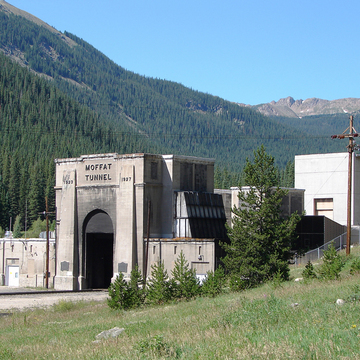This 6.2-mile-long rail passage under the Continental Divide, a National Engineering Landmark, was built by the Moffat Railroad. It was the longest tunnel in the Western Hemisphere when completed, although only half the length of the Simplon tunnel (1906) through the Alps between Switzerland and Italy.
Floods such as an 1,800-gallon-per-minute flow from Crater Lake, 1,300 feet overhead, drowned out hopes for a natural rock tunnel and made a steel and concrete lining necessary. The 1928 grand opening gave Denver a long-awaited direct rail route through the Rockies. The Denver & Rio Grande Railroad acquired the Moffat in 1947 and still uses the tunnel. Rail fans gather to see the great canvas curtain, designed to improve ventilation and keep out animals, raised and lowered as trains rumble through the pedimented concrete entry.
The Moffat Tunnel considerably shortened the original 26-mile roadbed between what are now its east and west portals. This abandoned rail route is now a summer jeep road and winter excursion for cross-country skiers and snowmobilers. The ride, which climaxes with the Corona Station, atop 11,600-foot Rollins Pass, includes Needles Eye Tunnel, 19.8 miles west of Rollinsville, and a view of an unusual square water tower, 8.7 miles west of Rollinsville.

